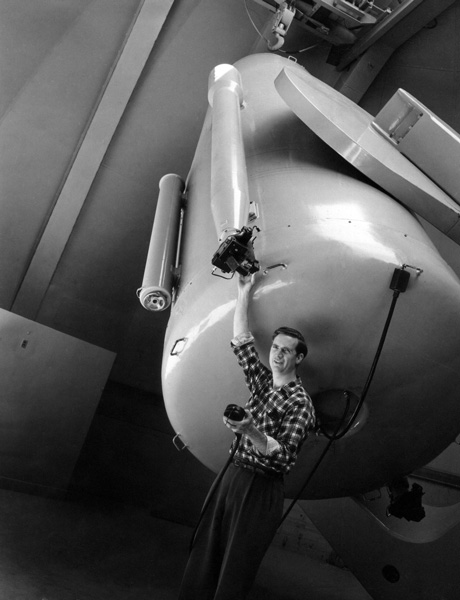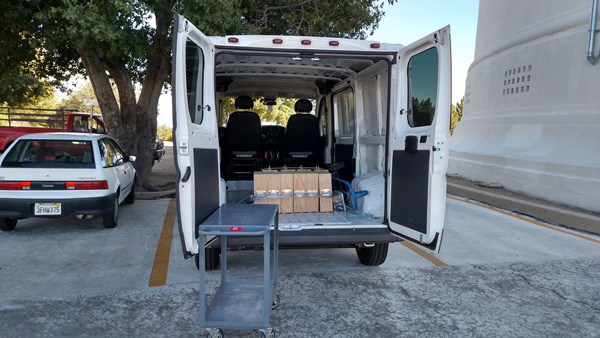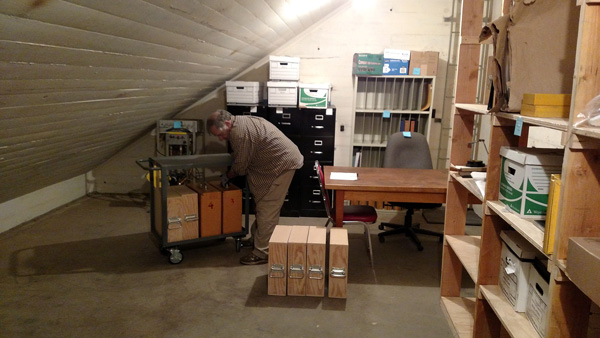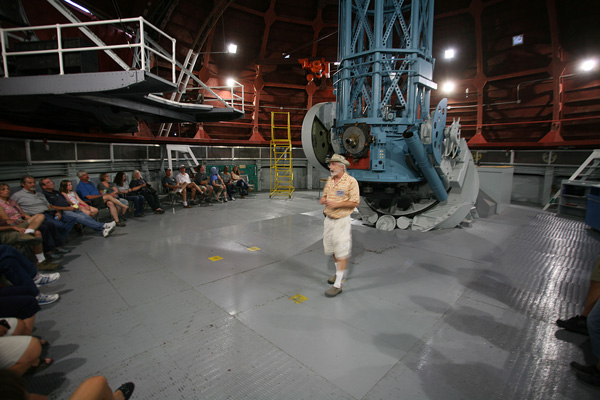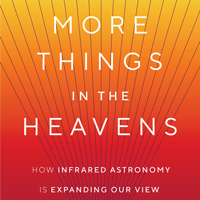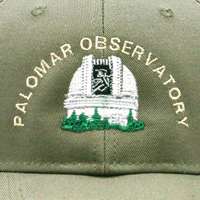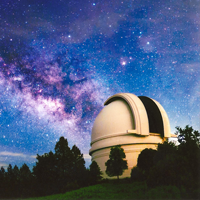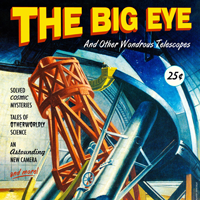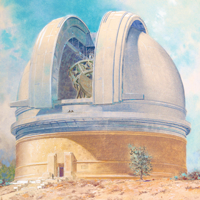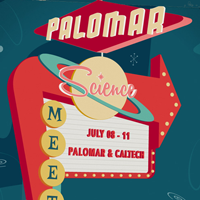Friends of Palomar Observatory Website
Upcoming Events

The Newsletter of the Friends of Palomar Observatory, Vol. 10 No. 2 – October 2015
Research in Astronomy and Astrophysics at Palomar Observatory
By Steve Flanders
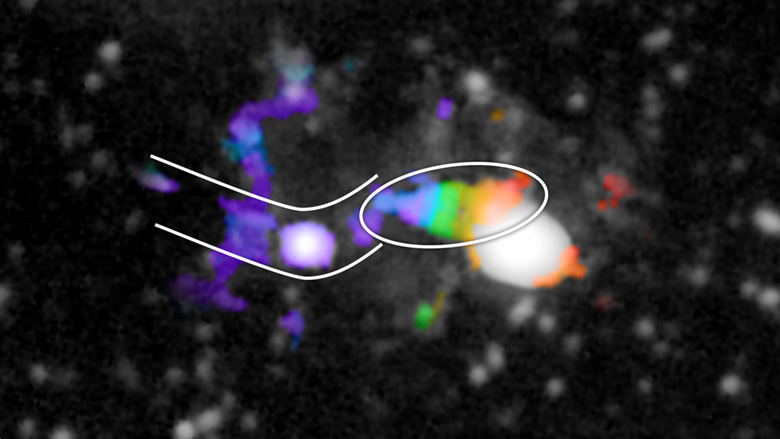
A team of astronomers led by Chris Martin has for the first time revealed a giant swirling disk of gas—a protogalaxy—10 billion light years away and four times the size of the Milky Way. Occurring at an early stage in the evolution of our universe, in this image the red portions are moving away from us while the blue side is moving toward us. (C.Martin/PCWI/Caltech)
Everyone associated with the Observatory is proud of the fact that after 66 years of service the Hale Telescope is still supporting world-class research in astronomy and astrophysics. The list of discoveries made with this telescope is a long one. You can see a representative list of Hale Telescope discoveries on our website.
As George E. Hale anticipated, the telescope began supporting important discoveries in cosmology immediately after it went into service in 1949. And remarkably this string of discoveries continues down to the present. Recently, a team of researchers led by Caltech astronomer Chris Martin discovered a giant disk of gas 10 billion light-years away, a galaxy-in-the-making that can be seen to draw material from the cool gasses of the intergalactic medium. As Martin has said, “this is the first smoking-gun evidence for how galaxies form.” You can read a detailed description of this discovery and watch a discussion with Chris Martin in this Caltech news article.
Questions of this sort involving the structure and evolution of galaxies and of the universe is currently a topic of major interest. But as you might expect, there are many areas of concern and interest to those working in the field of astrophysics. And looking over the research programs that have been supported by the Hale Telescope over the last six months, I was impressed by the breadth of research being conducted at this institution.
Since we get asked about this all the time, I therefore sat down to categorize and enumerate the various types of programs scholars bring to Palomar. I wanted to make a simple listing that included an estimate of the amount of time devoted to each category.
I came up with a set of categories and I think it is fair to say that at Palomar Observatory we are involved in many significant areas of research currently of interest in the field of optical and infrared astronomy.
By topic, let me summarize what I found for the period from the first of February 2015 to the end of July 2015:
Solar System Objects: 12 Nights
Studies of satellites and small Solar System bodies with the object of learning more about the formation of the Solar System.
In one case, Mike Brown of Caltech recently made observations of Jupiter’s satellite Europa in order to support instrument development programs at JPL where planning for a mission to Europa is underway.
Gregg Hallinan at Caltech is seeking to discover Kuiper Belt Objects by looking for occultations of background stars. To do this, he is using a sophisticated high speed photometer named CHIMERA.
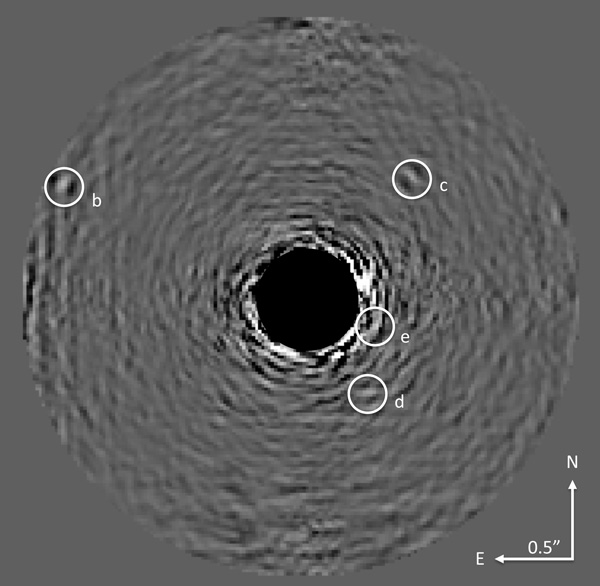
Charles Beichman and Rebecca Oppenheimer observed the planetary system around HR8799 with the Project 1640 imaging spectrograph. They were able for the first time to acquire the spectra of four exoplanets simultaneously. In this image, the light of the host star is blocked by an occulting disk. The four spots indicated by letters are the planets. (R.Oppenheimer/P1640/AMNH)
Exoplanets: 56 Nights
Studies that seek to confirm the existence of planets orbiting other stars and to characterize the masses, orbital periods, and physical compositions of these objects.
A few years ago a team led by Chas Beichman of Caltech and Rebecca Oppenheimer of the American Museum of Natural History completed a set of observations during which for the first time they obtained simultaneously the spectra of the four planets that orbit the star HR8799. They used an instrument known as Project 1640—a spectrographic imager and chronograph combined with the Hale Telescope’s adaptive optics system.
Finding exoplanets that reside in their host stars’ “habitable zone” has been the goal of a number of research programs. Recently Steven Pravdo of the Jet Propulsion Laboratory has been making precise measurements of the distances to a number of nearby stars that harbor exoplanets. With these distance determinations, he will more precisely be able to establish the orbital characteristics of these objects.
Black Holes and High Energy Transients: 30 Nights
Studies of supernovae, black holes, gamma ray bursts, active galactic nuclei, and extreme and unusual quasars among others.
Recently, George Djorgovski of Caltech made the first identification of a close supermassive black hole binary system on the basis of periodic brightness variations. Residing at the center of a galaxy, the interactions between these two objects may generate detectable gravity waves as the two black holes begin to merge.
Anestis Tziamtzis of the National Astronomical Observatories of China has been looking for the optical components of certain gamma-ray objects discovered by the Fermi space telescope. Specifically, he is looking for burst counterparts that vary at optical wavelengths. Tziamtzis argues such objects would be candidate millisecond pulsar binaries—important probes of relativistic physics.
Tom Prince of Caltech has been researching what are termed “black widow” millisecond pulsars. These are pulsars in tight orbits with a companion star in which the pulsar actually pulls material off the surface of the companion. Prince is studying the manner in which these interactions cause changes in color, temperature and other characteristics.
Fiona Harrison of Caltech and Daniel Stern of JPL have been looking for the optical counterparts of hard X-ray sources detected by the NuSTAR orbiting X-ray telescope. Once an optical counterpart is detected, it is then possible to use the Hale Telescope to obtain a spectrum of the object. From the spectrum, the redshift can then be determined and from that the object’s distance can be estimated.
Patrick Morris of JPL has been concerned with a special type of star, Wolf-Rayet stars, within our own galaxy. These objects are characterized by extreme loss of mass and by an unusual set of emission lines in their spectra that are thought to indicate a state in which a supernova is imminent.
Galaxies and the Evolution of the Universe: 66 Nights
Studies that seek to characterize how star formation, dark matter, the enrichment of the intergalactic medium, and mergers alter the nature of galaxies over time.
Of course, as noted at the beginning, Chris Martin’s discovery of a 10 billion year-old proto-galaxy represents an extremely important advance in our understanding of the evolution of the universe.
Erik Tollerud of Yale University believes that dwarf galaxies are important to our understanding of the dynamics and evolution of the Milky Way. Some objects that look like local dwarf galaxies may, however, be far in the background or may represent unusual structures within our galaxy. He has used the Double Spectrograph to obtain the spectra of candidate objects to determine their distances.
Now at the University of London after many years at Caltech, Richard Ellis has done studies of dark matter in nearby dwarf galaxies. He argues that, by accurately determining the density of dark matter in these galaxies, we may be able to determine the characteristics of the dark matter particle itself.
Lee Armus of JPL has studied galactic scale winds of dust and gas that are driven by the collective effects of massive stars and supernovae. He is working to show that these winds are the source that both heats and provides heavy element enrichment to the intergalactic medium. As they cycle back into a galaxy, these materials enhance the star formation process and therefore play a vital role in the process of galactic evolution.
Engineering, Maintenance and Miscellaneous: 17 Nights
A variety of other studies are undertaken on the Hale Telescope. Maintenance of the telescope is a top priority of the Observatory’s staff. And engineering work goes on continuously to upgrade and enhance the cameras and other detectors.
As one example of the various types of other studies that are done here, recently Eric Bellm of Caltech has been conducting a survey of variable objects in the northern section of the galactic plane. He is using the Double Spectrograph for classification of a number of different types of objects that vary in brightness.
In another example, Matthias Tecza of the University of Oxford is examining spectrographically several instances of gravitational lensing.
Dimitri Mawet of Caltech recently made an extensive set of improvement to wave front control capabilities of the Hale Telescope’s adaptive optics system known as PALM-3000.
The staff at the Observatory is conducting mirror reflectivity tests. This is an ongoing effort to determine the manner in which its reflectivity changes over time. The data this are obtained will be part of our quality assurance tracking program.
Led by Andy Boden of Caltech, students come to the Observatory several times during each semester. Known as the SURF program, senior scholars at the Institute mentor undergraduates. Together they establish research programs that the undergraduates carry out on the Hale Telescope. In this way, these students work with researchers at the highest levels of the profession: they make proposals; they complete a program of investigation using the state-of-the-art resources of Palomar Observatory; and they write up their findings and defend their conclusions. In this way they learn how world-class science is done.
I hope this listing provides some sense of rich variety of studies being conducted here at the Observatory. Given that there is some overlap in these categories, nothing has been counted twice and we end up with a listing that covers all 181 nights on the schedule from February to July of this year.
Palomar Legacy—Reconnaissance and Detailed Studies
By Andy Boden
Picking up on a thread I left hanging in our Spring Newsletter, I have some good news to report: George Abell’s galaxy cluster survey plates have returned home to Palomar. My longtime Palomar colleague Jean Mueller and I—working in conjunction with astronomers at UCLA—have retrieved the 48-inch Samuel Oschin Telescope plates used by Prof. Abell in his seminal thesis work and follow-up studies of galaxy clusters (back in the spring I connected the arc of this work to the present-day frontiers of observational cosmology). On 31 August, Jean and I retrieved ten boxes of P48 plates at UCLA, and the following day, 01 September, I drove the plate boxes to Palomar where observatory staff members Steve Flanders and John Henning helped me unload and store these plates in the Hale Telescope dome coudé mezzanine room. This is a happy homecoming for an important part of Palomar’s legacy, and part of a larger effort led by Jean to organize and curate Palomar Observatory artifacts—more on that in a later newsletter.
Stepping back, this Abell plate homecoming is also an opportunity to consider what has made Palomar so important in modern astronomy. When people visit or think of Palomar they usually focus on and marvel at the Hale Telescope. The Hale’s size, central location, and accomplishments command this deserved respect. But a balanced perspective on Palomar’s legacy make clear that the Samuel Oschin Telescope has easily made its share of lasting contributions to modern astronomy: the two epochs of the Palomar Sky Survey and associated work by astronomers such as Abell and Willem Luyten; study of trans-Neptunian objects and the famous “demotion” of Pluto’s planetary status by Mike Brown and collaborators; and the current and forthcoming work of the Palomar Transient Factory (PTF) and Zwicky Transient Facility (ZTF) to name a few (a more complete list can be found at the Palomar Observatory website Oschin Telescope page).
Hale is properly credited for the vision and drive to create Palomar Observatory centered on the 200-inch telescope—an instrument well-suited to focused, detailed studies of specific astrophysical questions. But great credit for Palomar’s success must also be shared with two other patriarchs of Caltech Astronomy—Fritz Zwicky and Jesse Greenstein. Framed by scientific collaboration with Walter Baade, Zwicky grasped the important, complementary role that broad reconnaissance should play to the detailed studies enabled by the Hale, and saw the potential of the newly-invented Schmidt telescope in realizing that reconnaissance. Greenstein understood and supported Zwicky’s vision in his role as Caltech’s first Astronomy Director, facilitating the development and deployment of Schmidt survey telescopes (the 18-inch and the Samuel Oschin Telescope) at Palomar.
I believe history will judge Palomar’s astronomical legacy as equal parts understanding gained by detailed study of highly focused questions, and the discoveries and insights gained by broad survey of the universe around us. The arc of the Observatory’s success rests firmly in these complementary contributions.
The Friends of Palomar Observatory, 2015
We have had a fine season during which the Friends of Palomar Observatory participated a set of well-attended and memorable events.
In April at the Palomar College Planetarium, Shri Kulkarni presented a discussion of the progress of the Zwicky Transient Facility, the successor to the Palomar Transient Factory and the intermediate Palomar Transient Factory. When it comes into service in 2017, the Zwicky Transient Facility will greatly expand upon the cadence and coverage achieved by the earlier programs. After Shri’s talk, Mark Lane, the director of the Planetarium and professor of astronomy at the college, gave the Friends a planetarium show and movie.
In June, we gathered at Mt. Wilson Observatory where we enjoyed a comprehensive and perhaps exhaustive tour given Mt. Wilson docent Nik Arkimovich. At the end of the tour, the people at the observatory treated us to lunch at the Cosmic Café.
At the beginning of August, Caltech professor Evan Kirby joined the Friends of Palomar Observatory at the Outreach Center. Evan gave a presentation on the new subject of galactic archaeology (also referred to as stellar archaeology). In this discussion, he described his continuing studies of nearby dwarf and low surface brightness galaxies arguing the materials that remained in the stars of these objects reveal the history of earlier periods of star formation. After his talk and despite some high cloud and bright moonlight, we all enjoyed at star party on the back parking lot.
Now there is a single event left for the 2015 season. On Saturday, October 17, we will meet at the Outreach Center starting at 3:00 pm. We will hold a reception and a presentation. At 4:30 pm, we will go to the 48-inch Samuel Oschin Telescope for a tour of the instrument that performed the Palomar Sky Survey and is currently the survey instrument for the intermediate Palomar Transient Factory. Jean Mueller, who worked on the second Palomar Sky Survey and is the Observatory’s long time telescope operator, will conduct the tour.
From the Samuel Oschin Telescope, we will proceed to the Hale Telescope dome for a tour of the 200-inch. At the close of this tour we will remain on the observing floor for the opening of the dome. We expect that this event will be concluded by 7:30 pm.
The tour of October 17 represents a rare opportunity to see the Samuel Oschin Telescope. Unfortunately I am limited in the number of people I can take on this tour and, as of this writing, the tour is filled. That said, if you would like to attend please send to me an email at sbf [at] astro.caltech.edu and I’ll make sure you get on the waiting list.
And I think we can all look forward to another fine season in 2016.
- Steve Flanders
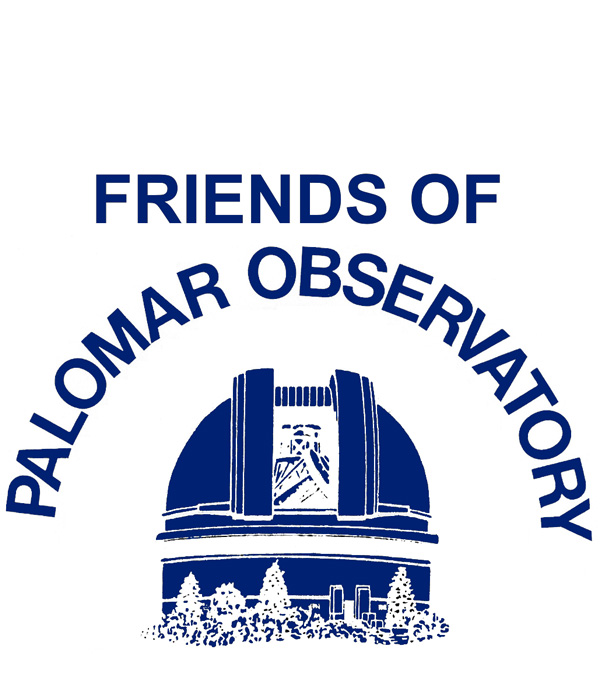
Questions? We've answered many common visiting, media, and academic questions in our public FAQ page.
Please share your feedback on this page at the
COO Feedback portal.
Big Eye 10-2
Last updated: 5 October 2015 SBF/AFB/ACM
